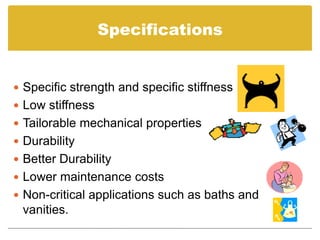Polymer composites
- 1. Polymer Composites (Construction Materials) By:- Kartikeya Pandey SAP ID :- 500021353
- 2. Polymer Raisin 1 Polymer Composites Polymer Raisin 2 / Fillers
- 3. Polymer Composites Natural Fibre Bio Fibre Composites Composites Composites
- 4. Fibre Composites Under investigation since the 1960’s repair of existing structures Bonds well, Easy to shape, enhancement of strength, Low stiffness, Durability. Rehabilitation & retrofit. replacement for steel. • fibre reinforced polymer
- 5. Combine plant-derived fibres with a plastic binder Wood, sisal, hemp, coconut, cotton, flax, jute, abaca, banana leaf Light weight, low-energy production and sequestration of carbon dioxide Semi-skilled indigenous workers Removes concern about the potential of lung disease by glass fibre
- 6. formed by a matrix (resin) and a reinforcement of natural fibres. environment-friendly biodegradable composites to biomedical composites. Characterised by the petrochemical resin replaced by a vegetable , animal resin or the bolsters (fiberglass, carbon fibre or talc) are replaced by natural fibre (wood fibres, hemp, flax, sisal, jute...)
- 7. Lack of designers experienced Processes Analytical hierarchical process Whole of life process Cost Short Term Cost Direct costs Fabrication Cost Costing of fibre
- 8. Specifications Specific strength and specific stiffness Low stiffness Tailorable mechanical properties Durability Better Durability Lower maintenance costs Non-critical applications such as baths and vanities.
- 9. Present Scenario Largest Consumer is Construction Industry. High use in Non-load bearing applications. Reinforced polymer composites (RPCs) (LOAD BEARING APPLICATIONS) Rehabilitation and Retrofit Less Environmental Hazardous (no resources)
- 10. Enormous Effort to migrate to polymer composites. Cradle to the Cradle approach Increase use of natural fibres(diversify). Does not cause pollution. Environmental sustainability. Non-renewable natural resources and lower embodied energy are safe.
- 11. THANK YOU & HAPPY TEACHERS DAY










